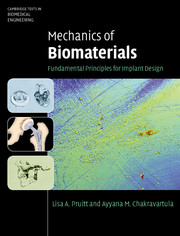Book contents
- Frontmatter
- Contents
- Symbols
- Prologue
- Part I Materials
- Part II Mechanics
- 6 Elasticity
- 7 Viscoelasticity
- 8 Failure theories
- 9 Fracture mechanics
- 10 Fatigue
- 11 Friction, lubrication, and wear
- Part III Case studies
- Epilogue
- Appendix A Selected topics from mechanics of materials
- Appendix B Table of material properties of engineering biomaterials and tissues
- Appendix C Teaching methodologies in biomaterials
- Glossary
- Index
- References
7 - Viscoelasticity
from Part II - Mechanics
Published online by Cambridge University Press: 05 June 2012
- Frontmatter
- Contents
- Symbols
- Prologue
- Part I Materials
- Part II Mechanics
- 6 Elasticity
- 7 Viscoelasticity
- 8 Failure theories
- 9 Fracture mechanics
- 10 Fatigue
- 11 Friction, lubrication, and wear
- Part III Case studies
- Epilogue
- Appendix A Selected topics from mechanics of materials
- Appendix B Table of material properties of engineering biomaterials and tissues
- Appendix C Teaching methodologies in biomaterials
- Glossary
- Index
- References
Summary
Inquiry
How are the material properties of cartilage and polymer bearing materials affected by the rate and duration of applied loading? How then does one design with biomaterials, accounting for time-dependent material properties?
The majority of important biomaterials, polymers, and tissues, for example, express some of the most complicated mechanical behaviors. When subjected to a constant load these materials will relax and continue to deform potentially indefinitely in a process called creep, making their use in structures problematic. Further, their response to high-frequency loading may differ dramatically from that observed under quasi-static conditions, directly impacting their performance in service. For instance, imagine the dynamic loading experienced by natural cartilage or a total knee replacement during downhill skiing, and how this rapid and severe loading could differ from the carefully controlled quasi-static testing typically performed in a laboratory. Comprehensive and effective modeling techniques are needed to properly account for time-dependent material properties in viscoelastic materials.
Overview
Viscoelastic materials, displaying both solid-like and fluid-like characteristics, are common in biomedical applications, from polymeric structures and coatings, to load-bearing connective tissues. The behavior of these materials cannot be described using only linear elasticity or plasticity theory, as is typical for many engineering materials. Rather, they are best described as having time-dependent material properties, such as an effective elastic modulus that is a function of the duration of applied loading. This time-dependence is usually associated with a characteristic time scale, called the relaxation time, and for time scales much greater or less than the relaxation time the material may not appear viscoelastic at all. Mathematical models of varying complexity can capture this behavior well, many times with only two or three material constants. Energy dissipation from the fluid-like part of the response can be separated from solid-like energy storage using a complex modulus, where they are represented by an imaginary and real part (respectively) of a complex material property (discussed below). In some cases, the material behavior is not simple enough to be represented by linear superposable functions, and nonlinear methods are especially suitable, for example when the unloading response does not match the loading response of the material.
- Type
- Chapter
- Information
- Mechanics of BiomaterialsFundamental Principles for Implant Design, pp. 208 - 240Publisher: Cambridge University PressPrint publication year: 2011

